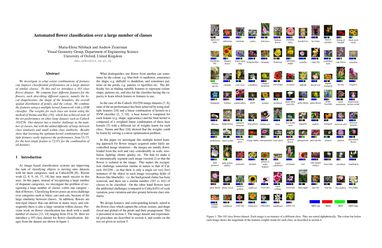Automated Flower Classification over a Large Number of Classes
We investigate to what extent combinations of features can improve classification performance on a large dataset of similar classes. To this end we introduce a 103 class flower dataset. We compute four different features for the flowers, each describing different aspects, namely the local shape/texture, the shape of the boundary, the overall spatial distribution of petals, and the colour. We combine the features using a multiple kernel framework with a SVM classifier. The weights for each class are learnt using the method of Varma and Ray [16], which has achieved state of the art performance on other large dataset, such as Caltech 101/256. Our dataset has a similar challenge in the number of classes, but with the added difficulty of large between class similarity and small within class similarity. Results show that learning the optimum kernel combination of multiple features vastly improves the performance, from 55.1% for the best single feature to 72.8% for the combination of all features.
PDF AbstractDatasets
Introduced in the Paper:
 Oxford 102 Flower
Oxford 102 Flower


